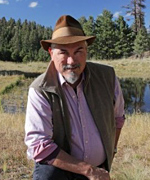 —Alan Dulaney
—Alan Dulaney
Looking back, some important things came out of 2019. The Drought Contingency Plan legislation was signed, the Water Augmentation, Innovation, and Conservation Council was created, and the Bureau of Reclamation moved up the schedule for negotiating the next set of shortage guidelines amongst the Lower Colorado River Basin states.
But perhaps one of the most significant events for hydrologists was the release by the Department of Water Resources of the new and much anticipated groundwater model for the Pinal Active Management Area in 2019. The last regional model, released by ADWR in 2014, was peer-reviewed by USGS, University of Arizona, and S.S. Papadopulos Associates hydrologists and pronounced suitable for the model goals. The goals of the 2019 model were to better understand regional groundwater flow, use the model for predictive tool, and support regulatory decision-making, especially for Assured Water Supply purposes. Building on the 2014 base, the new model received some major modifications and upgrades. Pumping and recharge information was updated for the 2010-2015 period, various MODFLOW packages were improved, and the grid was revised. Importantly, new geological interpretations from SRP and Arizona Geological Survey studies plus well construction information provided a more detailed understanding of the basement geometry, increasing aquifer thicknesses in most areas and decreasing depth to bedrock values in others.
Assumptions were made concerning agricultural pumping: steadily declining demand with increasing urbanization, Central Arizona Project deliveries only through 2030, no further pumping in areas covered by Assured Water Supply determinations. Agriculture dependence on groundwater remains the largest demand through 2115 and was calculated based on 2015 reported volumes. Increased pumping envisioned in the Drought Contingency Plan was not included. For the Gila River Indian Community, agricultural groundwater demand was simulated as increasing even with full CAP deliveries after 2029. For municipal demand, assumptions included full pumping of all constructed Certificated subdivisions and Designations at 2015 levels. Approved Analyses were incorporated at full approved volumes, as were the unconstructed portions of Certificated subdivisions. No pending or proposed Assured Water Supply demands were included, only the already approved pumping. Further assumptions revolved around recovery of Long-Term Storage Credits, incidental recharge, and effluent. The assumptions are complex and interlocking, but comprehensive; this model is solidly based on sound hydrology.
Then, with the goal of regulatory decision-making in mind, ADWR ran the model for the time frame 2016-2115. The model run predicted unmet demand of 8.1 million acre-feet over 100 years. Model layers were dewatered, water levels in wells fell below 1100 ft BGS, saturated thicknesses, thus transmissivities, lowered significantly, and dry cells appeared. These effects were not uniform across the model area, being most pronounced south of Eloy.
Insufficient groundwater supplies exist to meet already-issued Assured Water Supply demands over 100 years, particularly Analyses. This means physical availability cannot be proven not just for newly proposed, but also for some approved but as-yet unbuilt, subdivisions. This puts ADWR in uncharted waters, as a prioritization process exists for allocating physical availability amongst competing pending applications, but not for existing and approved demands. ADWR has drafted a policy to meet the new conditions.
ADWR Director Tom Buschatzke bluntly told the Legislature in October that, “Looking out 100 years, there is insufficient groundwater in the Pinal Active Management Area to support all existing uses and issued assured water supply determinations.” And if the demand for already-approved determinations can no longer be met, then most certainly there will be no new approvals of Assured Water Supply applications within the Pinal Active Management Area.
The implication is that development will not proceed to replace agriculture as long envisioned, and is unlikely to proceed at all. ADWR has only rarely shut down development within an Active Management Area based on lack of physical availability. The Cave Creek-Carefree area went under a building moratorium decades ago as groundwater levels declined dramatically, but a pipeline was completed to deliver Central Arizona Project water and developers were back in business. CAP isn’t riding to the rescue this time.
The development community is keenly aware of the implications of the model run. Well-funded and politically powerful, they know that a sound regional model makes an excellent regulatory tool. They also know that the Assured Water Supply rules are susceptible to pressure. Pinal will become a major test of water vs. money in the years to come.